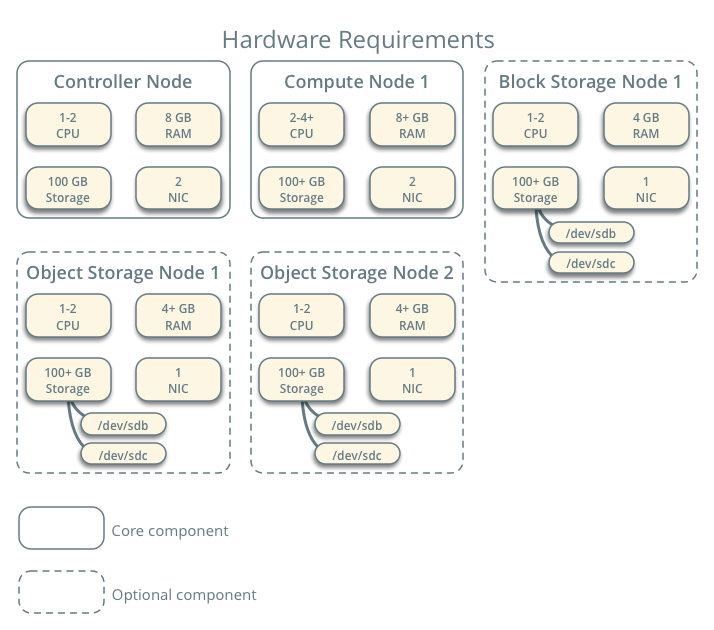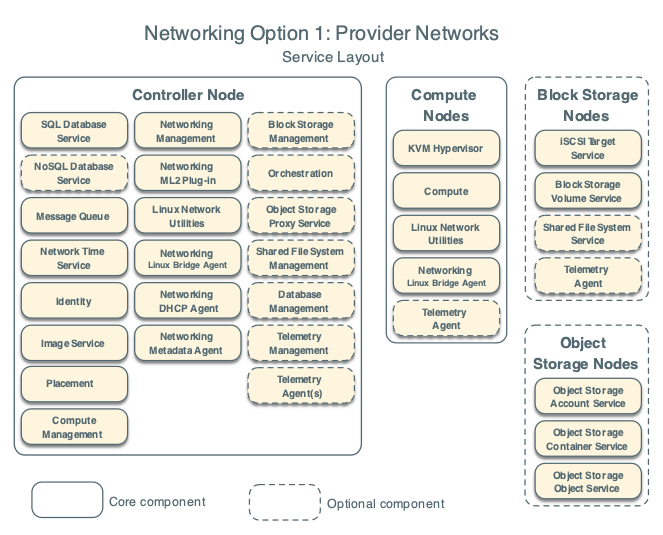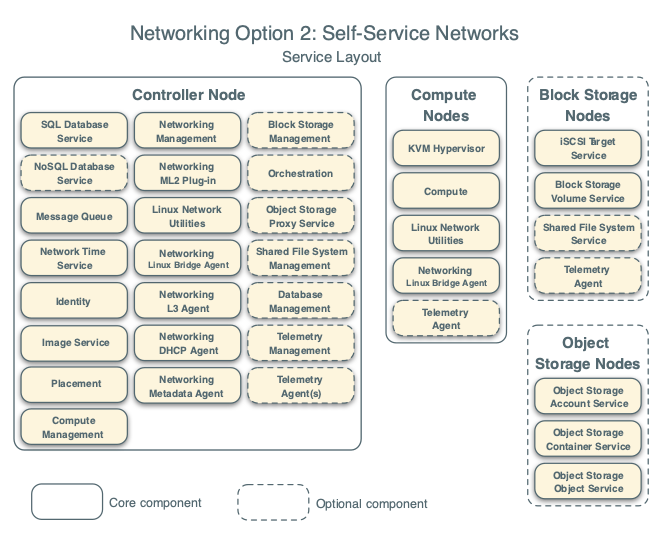Обзор¶
The OpenStack project is an open source cloud computing platform that supports all types of cloud environments. The project aims for simple implementation, massive scalability, and a rich set of features. Cloud computing experts from around the world contribute to the project.
OpenStack provides an Infrastructure-as-a-Service (IaaS) solution through a variety of complementary services. Each service offers an Application Programming Interface (API) that facilitates this integration.
This guide covers step-by-step deployment of the major OpenStack services using a functional example architecture suitable for new users of OpenStack with sufficient Linux experience. This guide is not intended to be used for production system installations, but to create a minimum proof-of-concept for the purpose of learning about OpenStack.
After becoming familiar with basic installation, configuration, operation, and troubleshooting of these OpenStack services, you should consider the following steps toward deployment using a production architecture:
Determine and implement the necessary core and optional services to meet performance and redundancy requirements.
Increase security using methods such as firewalls, encryption, and service policies.
Use a deployment tool such as Ansible or Puppet to automate deployment and management of the production environment. The OpenStack project has a couple of deployment projects with specific guides per version: - 2023.2 (Bobcat) release - 2023.1 (Antelope) release - Zed release - Yoga release - Xena release - Wallaby release - Victoria release - Ussuri release - Train release - Stein release
Пример архитектуры¶
The example architecture requires at least two nodes (hosts) to launch a basic virtual machine or instance. Optional services such as Block Storage and Object Storage require additional nodes.
Важно
The example architecture used in this guide is a minimum configuration, and is not intended for production system installations. It is designed to provide a minimum proof-of-concept for the purpose of learning about OpenStack. For information on creating architectures for specific use cases, or how to determine which architecture is required, see the Architecture Design Guide.
Этот пример архитектуры отличается от минимальной производственной архитектуры следующим образом:
Сетевые агенты находятся на управляющем узле вместо одного или нескольких выделенных сетевых узлов.
Оверлейный (туннельный) трафик для собственных сетей проходит через управляющую сеть, а не через выделенную.
For more information on production architectures for Pike, see the Architecture Design Guide, OpenStack Networking Guide for Pike, and OpenStack Administrator Guides for Pike.
For more information on production architectures for Queens, see the Architecture Design Guide, OpenStack Networking Guide for Queens, and OpenStack Administrator Guides for Queens.
For more information on production architectures for Rocky, see the Architecture Design Guide, OpenStack Networking Guide for Rocky, and OpenStack Administrator Guides for Rocky.

Аппаратные требования¶
Контроллер¶
На узле контроллера запускает служба идентификации, служба образов, службу размещения, управляющие модули вычеслительных ресурсов, управляющие модули сетевых агент, различные сетевые агенты и панель Управления. Также он включает вспомогательные службы, такие как база данных SQL, message queue, and NTP.
Дополнительно, узел контроллера может запускать управляющие модули блочного хранилища, хранилища объектов, службы оркестрации и телеметрии
Узел управления требует как минимум два сетевых интерфейса.
Вычислительные ресурсы¶
The compute node runs the hypervisor portion of Compute that operates instances. By default, Compute uses the KVM hypervisor. The compute node also runs a Networking service agent that connects instances to virtual networks and provides firewalling services to instances via security groups.
Вы можете развернуть несколько вычислительных узлов. Каждый узел требует как минимум два сетевых интерфейса.
Блочное Хранилище¶
Необязательный узел Блочного хранения содержит диски блочного хранилища и служб общих файловых систем предоставляемые инстансам
Для простоты, служебный трафик между вычислительными узлами и этим узлом использует служебную сеть. Производственное окружение должно быть реализовано в отдельной сети хранилищ, для увеличения производительности и безопасности.
Вы можете развернуть более одного узла Блочного хранения. Каждый узел требует как минимум один сетевой интерфейс.
Хранилище объектов¶
Необязательный узел хранилища объектов содержит диски службы хранилища объектов для сохранения учетных записей, контейнеров и объектов.
Для простоты, служебный трафик между вычислительными узлами и этим узлом использует служебную сеть. Производственное окружение должно быть реализовано в отдельной сети хранилищ, для увеличения производительности и безопасности.
Эта служба требует два узла. На каждый узел требуется как минимум один сетевой интерфейс. Вы можете развернуть больше двух узлов хранилища объектов.
Сеть¶
Choose one of the following virtual networking options.
Networking Option 1: Provider networks¶
The provider networks option deploys the OpenStack Networking service in the simplest way possible with primarily layer-2 (bridging/switching) services and VLAN segmentation of networks. Essentially, it bridges virtual networks to physical networks and relies on physical network infrastructure for layer-3 (routing) services. Additionally, a DHCP service provides IP address information to instances.
The OpenStack user requires more information about the underlying network infrastructure to create a virtual network to exactly match the infrastructure.
Предупреждение
This option lacks support for self-service (private) networks, layer-3 (routing) services, and advanced services such as LBaaS and FWaaS. Consider the self-service networks option below if you desire these features.

Networking Option 2: Self-service networks¶
The self-service networks option augments the provider networks option with layer-3 (routing) services that enable self-service networks using overlay segmentation methods such as VXLAN. Essentially, it routes virtual networks to physical networks using NAT. Additionally, this option provides the foundation for advanced services such as LBaaS and FWaaS.
The OpenStack user can create virtual networks without the knowledge of underlying infrastructure on the data network. This can also include VLAN networks if the layer-2 plug-in is configured accordingly.

